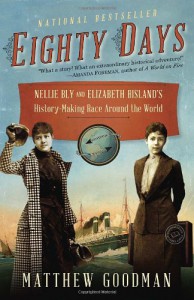
Around the World in 80 Days

Nelly Bly was, by 1889, already rather famous in New York as not only a muckraking investigative journalist, an unusual enough occupation for a woman of her day, but a very good one. In particular she was well known for spending 10 days undercover as a patient in a womens mental asylum, and exposing the horrors of the treatment within, with resulting massive changes to the system. As a publicity stunt then, the newspaper she worked for sent her off on a round the world trip, attempting to replicate, or even better beat, the fictional trip of Phileas Fogg in the Jules Verne novel
Not wanting to be outdone, a rival newspaper, with a scant few hours notice, sent it's own lady journalist, Elizabeth Bisland--who far from being a muckraking investigative journalist, was the cultured and very private literary page editor, more accustomed to tea parties and literary salons than mental asylums--on a race with Bly, going the other way around the world.
The story is fascinating for so many reasons. Women journalists in 19th century New York? Travelling unaccompanied and unchaperoned around the entire world? Primarily on public transport no less?
And then there's Bly. Bisland I'd honestly never heard of, but the name Nellie Bly rang a bell. So did the image of her, although I didn't immediately recognise it as her: The checked coat and cap, the leather grip bag, and the blue dress, indeed, I recognised that, and now I know why.
This book is meticulously researched. In fact while reading it, I couldn't figure out why the page count varied by some 25% between different book sites. Turns out, because that's about how much of it is annotations, endnotes, and citations, and some sites were counting those and some weren't.
But it's definitely not dry, as you might expect from the list of citations. In fact it's highly engaging, if prone to little wanderings into side topics. Not only did I learn a lot about both Bly and Bisland, but I also learnt an enormous amount about coal mining in the appalachians, New York, journalism in general, lunatic asylums in the 1880s, the history of Ceylon, Jules Verne and his wife (I can't recall ever having read anything biographical about his wife before anywhere!), the Sikh police force in Hong Kong and... well you get the idea.
 The journey itself, and the two women making it, were very much products of their time and society, as were their reactions to events and sights they encountered along the way. Along with the meanderings into peripheral topics, there is a tendency to switch to a very personal narrative point of view (".... she thought"), although the author is clear to point out, these are always based on personal letters and recollections written by the two women themselves.
The journey itself, and the two women making it, were very much products of their time and society, as were their reactions to events and sights they encountered along the way. Along with the meanderings into peripheral topics, there is a tendency to switch to a very personal narrative point of view (".... she thought"), although the author is clear to point out, these are always based on personal letters and recollections written by the two women themselves.
Also interesting to me is the impression I came out of at the end of the book. At the beginning, Bly seemed to me a brash but brave go-getter, and Bisland a bit of a toff, only going on the trip at all under protest. By the end of it, I had rather a different impression: Bisland comes off as thoughtful and thoroughly interesting, and Bly as a bit of a self-aggrandizing huckster, with a story that changes minute by minute to suit the audience.
I'm pretty sure, if I met them in person, I would have got along with Nellie Bly rather better than Elizabeth Bisland, but reading about them now, a century later, I can't help myself but admire Bisland more.
Go figure.
Anyway,although the meandering style was a little unexpected in the beginning so I confess it took me some time to get past the first third or so. But once I did, I found it a thoroughly fascinating portrait of not just two rather remarkable women, but of a time and place that I personally didn't know a whole lot about.
Images above:
Nellie Bly in her travelling outfit - she took only one dress on the entire trip, a fact that most (male) journalists found quite astonishing, that a woman could go on a journey of more than a week without a dozen trunks, let alone no trunks at all.
A rather cute Nellie Bly Doll from http://www.thetoyshoppe.com
Some more info:
Bisland herself, is not nearly as well represented, although both women wrote books about their journeys (and both of which I'm going to make an effort to find a copy of to compare them.)
 5
5











